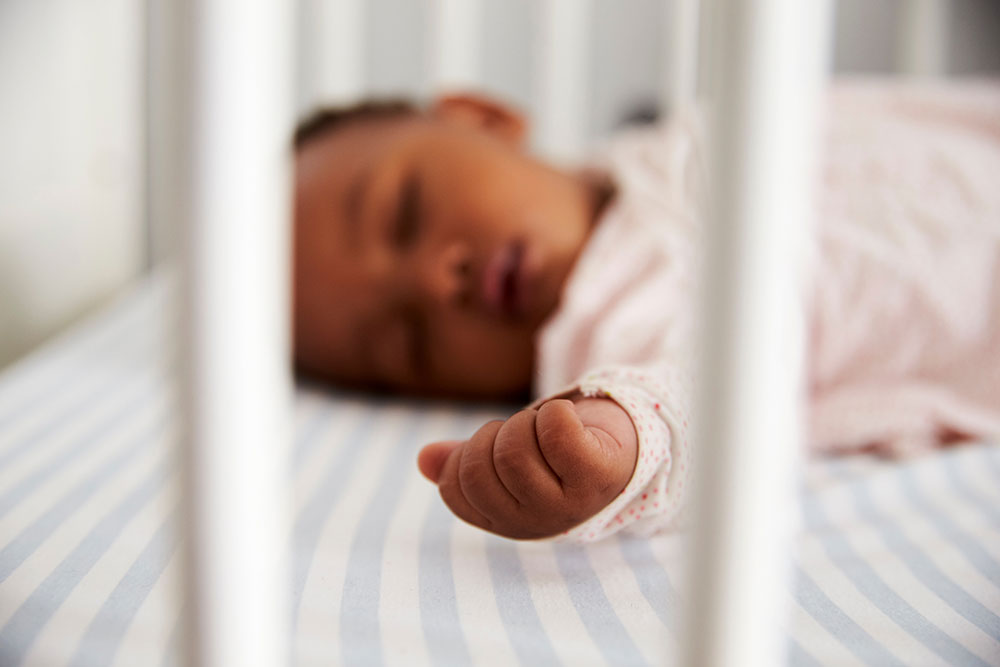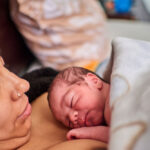Understanding New SIDS Research

Here’s what we have learned about the findings and what you can still do to lower the risk of SIDS.
Medical Experts: Dr. Carmel Harrington, PhD; Dr. Rachel Y. Moon, MD; Dr. Mary Beth Howard, MD; Benjamin Mazer, MD
You may have heard about a recent study out of Australia, how the world rejoiced, and how experts then put things in perspective. Read on for a better picture of what was found and what it means for parents today.
What the Research Showed
Researchers at The Children’s Hospital at Westmead in Australia found a potential biomarker for babies who die from sudden infant death syndrome (SIDS). The study, published in the journal eBioMedicine in May, showed lower activity in the enzyme butyrylcholinesterase (BChE) in the blood of newborns that later died from SIDS than in those who lived or died from other causes.
Though it isn’t certain, SIDS may be caused by brain abnormalities or genetic mutations. Another prevalent theory is the triple-risk model, which suggests that SIDS is likely when three factors occur at the same time:
- An infant is already vulnerable, such as a baby born prematurely.
- The baby is exposed to outside stressors, such as an unsafe sleep environment.
- The baby is in their critical development period, a time when they learn to respond to dangerous situations.
Given BChE’s role in the system that regulates sleep and wakefulness, researchers believe having this lower level could impact the brain’s ability to tell a baby to wake up, turn their head, or take a breath when in a life-threatening situation.
Lead researcher Dr. Carmel Harrington, PhD, told Pregnancy & Newborn that this is the first time a possible biomarker of infants at risk for SIDS has been discovered prior to death.
“Our finding raises, for the first time, the real possibility of one day being able to identify infants at risk for SIDS prior to death and to offer appropriate interventions,” Dr. Harrington says.
Dr. Harrington goes on to explain that this discovery changes the narrative around SIDS, and researchers now have the potential to work with living babies and make sure they keep living. Ensuring babies survive has been Harrington’s focus for more than two decades, ever since her son and a friend’s daughter died of SIDS.
“I made a solemn resolution there and then to leave no stone unturned in my quest to solve the mystery of SIDS,” she says on the crowdfunding page that has raised money for this study.
She has raised more than $80,000, tens of thousands of which poured in after the research was released.
“I have been overwhelmed by the generosity of the community,” she says, “And have been touched by the number of people who have reached out and shared their own personal stories with me.”
It’s an inspiring story of a mom on a mission to save other babies, and save families from overwhelming heartbreak. It’s a story that deserves recognition, but it’s also a story that experts say has, unfortunately, been misunderstood.
What Happened When the Study was Released (and What Could Happen Next)
People everywhere were understandably thrilled about these findings. “THEY FOUND THE CAUSE OF SIDS,” read one viral tweet. News outlets were quick to celebrate the study, but not long after, they had to pump the brakes. Suddenly it was a game of “this is exciting, but let’s put it in perspective.”
“This is an extremely small study,” Dr. Rachel Y. Moon, MD, chairperson of the American Academy of Pediatrics (AAP) Task Force on SIDS told Pregnancy & Newborn. “It is definitely not confirmed that this is ‘the cause of SIDS.’ The current hype, while understandable, is not warranted.”
The research had a small sample size, used blood that was collected between 2016 and 2020, and the lower levels could be due to other SIDS risk factors like low birth weights or the mother’s age, blood pressure, and/or use of alcohol, tobacco, or drugs during pregnancy.
Dr. Mary Beth Howard, MD, a pediatric emergency medicine physician at Johns Hopkins Children’s Center in Baltimore, Maryland, told Pregnancy & Newborn that next steps may include more sensitive measurements of BChE in larger sample sizes, as well as looking for other biomarkers that could play a role in predicting an infant’s vulnerability to SIDS.
“Preliminary research is important in generating theories and hypotheses about why something is occurring,” she says. “And this study does just that—there is a theory that this enzyme may play a role in SIDS-related deaths, but the exact role it plays is still uncertain.”
A representative from the Centers for Disease Control and Prevention’s (CDC) Division of Reproductive Health told Pregnancy & Newborn that their guidance regarding the risk for SIDS and other sleep-related infant deaths has not changed based on the study.
“As noted in the study, BChE may be considered a potential biomarker for SIDS,” they said. “Multiple, larger studies with more definitive findings are needed before clinical guidance can be revised to incorporate such new evidence.”
Dr. Harrington calls these findings “one piece of the puzzle” and agrees that more research is now required to validate and confirm the findings.
“Only then will it be possible to develop accurate screening tests and appropriate interventions.”
Benjamin Mazer, MD, a hospital pathologist at Yale New Haven Hospital in Connecticut, wrote for The Atlantic that even if a screening test for SIDS was developed, doctors might not want to use it. After all, every form of screening makes mistakes.
“Sometimes, the benefits from these tools are worth the harm of an occasional error … but a wonky SIDS test would have catastrophic ill effects,” he wrote.
He goes on to explain that a false positive would terrify new parents, and a false negative could lead them to abandon safe-sleeping practices. He also says early detection tests are only as good as the treatments used to respond to them. There is currently no treatment for SIDS, but there are things parents can do to reduce the risk.
What we do Know About SIDS and How to Help Prevent it
The CDC, reports that about 3,400 babies under the age of 1 die from a sudden unexpected infant death (SUID). SIDS accounts for 37 percent of those deaths.
SIDS is the number one cause of death for babies between 1 month and 1 year old, according to the National Institutes for Health, and the majority of those deaths happen before the baby is 6 months old. Among other things, SIDS is not contagious, not the result of child neglect or abuse, and unfortunately, not completely preventable.
Data also shows that there are racial and gender disparities among SIDS cases. The largest racial difference is that from 2014 to 2018, SIDS rates were around 90 deaths per 100,000 live births among American Indian/Alaska babies, and 14 per 100,000 among Asian/Pacific Islander babies. Male babies are also at slightly higher risk for SIDS than females. Just as the cause for SIDS is uncertain, so are the reasons for such differences.
The CDC reports that in 1990, around 130 babies died from SIDS per 100,000 live births. By 2019, that number dropped to around 33. This decrease is often attributed to safe sleep campaigns in the early 90s and continually updated safe sleep recommendations.
Some of the recommendations from the AAP (including additional guidance from June 2022) and supported by the CDC are as follows:
- During their first year of life, always place your baby on their back to sleep. (Make sure to communicate this to all caregivers, too.)
- Cribs, bassinets, and portable cribs should all have a firm, non-inclined sleep surface.
- If your baby falls asleep in anything else (a car seat, stroller, or carrier), move them to a firm, flat sleep surface as soon as possible.
- Ensure their crib meets all safety guidelines and that it has not been recalled.
- Use a firm mattress and a tight fitted sheet.
- Do not put blankets, pillows, stuffed toys, bumper pads of any materials, loose bedding or other soft objects in their sleep environment.
- Have your baby sleep in your room but not in your bed until they are at least 6 months old (preferably up to 12 months old). Bed-sharing is never recommended.
- Once your baby shows signs of being able to roll, stop swaddling. Do not use weighted swaddles.
- Do not let your baby get too hot while sleeping, as overheating comes with increased risk. If you are worried they are too cold, dress them in an appropriately sized wearable blanket like a sleep sack.
- Not all babies will take to a pacifier, but you should offer one when they go to sleep. Do not attach the pacifier to their clothing, and you don’t have to put the pacifier back in if your baby spits it out.
- Avoid commercial products that claim to reduce the risk of SIDS. There is no research backing these claims, and they may provide a false sense of security. That sentiment holds true for the claim that at-home cardiorespiratory monitors reduce the risk of SIDS.
It’s a lot to keep track of, but Dr. Howard uses a simple phrase to help parents remember important tenets.
“I share with them the ABCs of safe sleep: Alone, on their Back, in a Crib,” she says.
If a parent notices their infant having any trouble breathing, color changes like blue around their lips, or other concerning features, she says they should call 911 or seek medical attention immediately.
A vulnerable infant is also at higher risk for SIDS, so the AAP also recommends the following practices during pregnancy and postpartum:
- Mothers should schedule and go to all prenatal care visits.
- Mothers should not smoke, drink alcohol, or use drugs during their pregnancy. They should also avoid second-hand smoke.
- If they are able, mothers should breastfeed for as long as possible.
- Skin-to-skin contact is beneficial to both breastfed and bottle-fed babies.
- Parents should attend all their baby’s well visits and stick to their immunization schedule. As they do their best to reduce their child’s risk for SIDS, they should also vaccinate them against diseases that can be prevented or mitigated. The CDC reports that research has not shown that childhood vaccines cause SIDS.
Regardless of the future implications of her research, Dr. Harrington reminds families to not lose sight of the fact that these recommendations have drastically reduced the incidence of SIDS. From 1994 when the Safe to Sleep Campaign started in the U.S., the rates of back sleeping more than doubled, and the incidence of SIDS dropped by more than half.
“I urge everyone to keep in mind that safe sleep practices play a vital role in keeping our infants safe,” she says. “I strenuously encourage parents everywhere to continue to practice this advice.
For more guidance around lowering the risk of SIDS, resources such as grief counseling, or ways to support research and families affected by SIDS, visit the CDC’s resource list.







